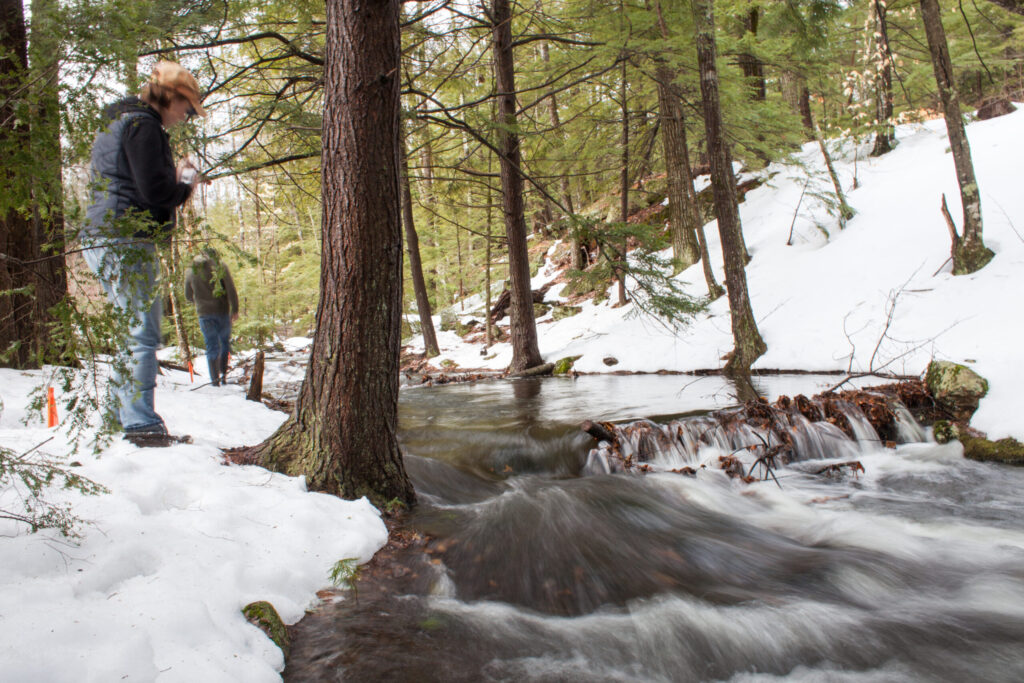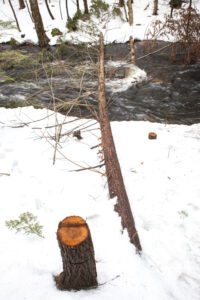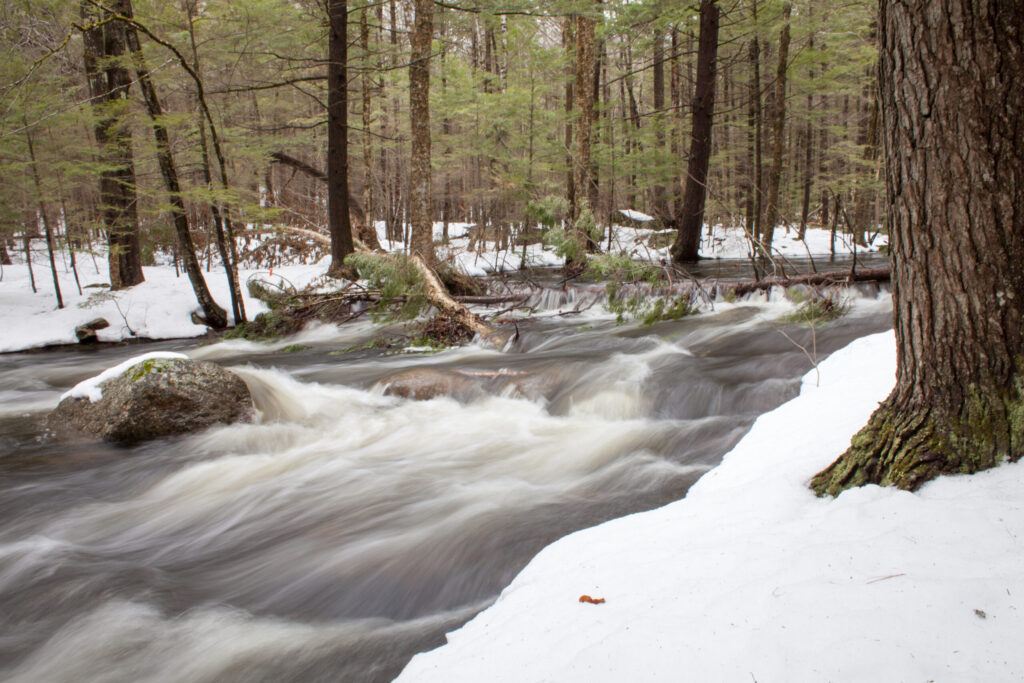What do New England’s rivers need most? Ask Erin Rodgers and Joel Destasio from the non-profit organization Trout Unlimited, and you might be surprised by the answer: more wood.
On a warm spring day, I joined Rodgers and Destasio in Deerfield, New Hampshire to find out why they are putting trees in rivers. As we trudged through mud and snow to reach the first site, Rodgers gave me a crash-course in how the region’s land-use history has led to sick rivers in desperate need of restoration (and trees).
It is a familiar one—the story starts in the 1700s and continues into the early 1800s, when New England’s forests were largely clear-cut and converted to farms and pasture. Without trees, the region’s rivers were unleashed.
With no roots to hold riverbanks together, no branches or downed trunks to slow the flow of water in streams, and runoff from the cleared landscape pouring unchecked into waterways, the balance between the cutting power of the rivers and the resistance of the banks shifted. Channels cut their way to straighter lines and became entrenched in deeper banks. Where rivers once meandered through the landscape, depositing nutrients in slow-moving sections and providing a wide array of aquatic habitats, they now barreled along straightaways.
For many underwater critters, including brook trout and other native fish species, this meant a housing crisis. For downstream towns and infrastructure, this meant flooding and damage. And even with the period of reforestation over the past 100 years, Rodgers says our streams haven’t bounced back yet.
“People think, ‘oh, as long as you have trees around [rivers], they are probably good or will be eventually,’” Rodgers explains. “But everything is in the same, fairly degraded state.”
In an effort to restore habitat and stream function, Trout Unlimited is employing “large-wood loading” and “chop and drop” programs. Wood loading is when trees are positioned in rivers to change the way water moves through a system. “Chop and drop” refers to trees that are cut along the edge of a river and dropped across the channel. Both methods create resistance and roughness in the current, leading to slower water above the structure, and faster rapids below.

Standing on the banks of Griffon Brook in Deerfield, New Hampshire, where Destasio and a crew of workers employed wood loading techniques on 1,000 feet of stream, Rodgers explained how it works. “Every time you put wood in streams like this, you’re slowing down the water, you’re adding roughness. Were this not all in here, this might be a straighter torrent just shooting past.” Rodgers said. “If we slow it down up here, it’s going to have a lot less of an effect when the water hits the town, and it will have a huge benefit to the in-stream system.”
 Slowing water down helps the stream in a number of ways. First, it creates a diversity of underwater habitats, including fast-moving rapids and slow-moving eddies. Slower moving water allows for nutrient deposition, which provides food for aquatic insects and also reduces the amount of nutrients that dump out into larger waterways downstream. The work has the added benefit of flood resilience in downstream towns.
Slowing water down helps the stream in a number of ways. First, it creates a diversity of underwater habitats, including fast-moving rapids and slow-moving eddies. Slower moving water allows for nutrient deposition, which provides food for aquatic insects and also reduces the amount of nutrients that dump out into larger waterways downstream. The work has the added benefit of flood resilience in downstream towns.
As Destasio explains, “During high flows, or big torrential downpours, that water isn’t going to end up in backyards.” Instead, restored areas will flood above wood loading structures, helping to reduce stream flows and flooding downstream.
For now, Trout Unlimited is prioritizing smaller streams for wood loading projects, because these tributaries will have a trickle-down effect for downstream rivers. Even with countless miles of streams in need of restoration, Destasio and Rodgers are hopeful that work like this will continue to spread throughout the region.
“You could do this kind of work in every single river or stream throughout New England, and it would have a huge benefit to the in-stream system,” Rodgers says.
While it only takes one or two days and a hardy crew of workers to complete 1,000 feet of stream restoration, the effort goes beyond the initial grunt work. Each project includes monitoring before, during, and after implementation to determine the work’s impact. Research teams collect data on streamflow and health, as well as native fish and aquatic insect populations. In areas where projects have been in place for years, the data indicates that wood loading can help increase trout and aquatic insect populations while providing increased flood resilience downstream.
In addition, hours of outreach and education back up every project, helping connect landowners, communities, and land managers with resources and best practices that will contribute to healthy streams throughout New England.
Back at the stream, Destasio and Rodgers take a final look at the meandering channel, complete with riffles, pools, and eddies—proof that their efforts are making a difference. The snow is melting quickly, and their boots are caked in a layer of mud. It is time to start planning the next restoration project.

Saving Forests, Saving Streams
Preserving and promoting water quality is just one of the many benefits of forest conservation. Forest soils help filter water, thus improving water quality; trees increase flood resilience by trapping rainfall and reducing runoff; tree canopies help shade and cool rivers, and their roots help stabilize banks; and as forests mature, older trees contribute naturally-occurring wood in the stream, reducing the need for wood loading efforts.
These benefits can be protected by responsible forest management practices that NEFF practices and promotes. For example, foresters can leave buffer strips along streams where harvesting is either very minimal or the trees are left untouched. Buffer strips help reduce runoff from the surrounding landscape, and the intact tree canopy shades the river and helps moderate summer water temperatures. Additionally, the tree roots stabilize river banks, preventing erosion.
The way that logging roads and skid trails are built and maintained in a harvest area can also impact water quality. First, selecting a pathway that is not on steep terrain will help reduce runoff. Second, installing water bars, or angled troughs cutting across roads or trails, helps to contain and direct runoff towards forested areas that will help slow the water down. Maintaining or removing these structures after logging operations are complete is crucial to ensuring that water is directed, filtered, and slowed down as much as possible.
In areas where stream crossings are required, temporary stream crossings help maintain proper stream ecology, and can be removed after a harvest is complete. In addition, conducting harvests in the winter when the ground is frozen can help reduce impacts on water quality.
Many of these procedures are required by each state’s Best Management Practices (BMPs), which serve as recommendations and regulations for harvest protocols. In addition to following BMPs, NEFF’s woodlands are certified by the American Tree Farm System® and Forest Stewardship Council™ standards, which include regulations and certifications to address water quality issues.
Writing and Photography by Charlie Reinertsen
